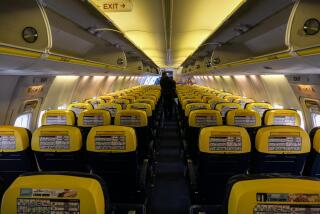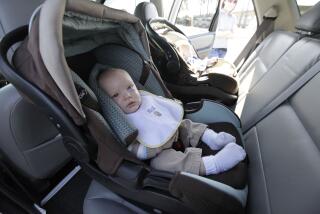On a family vacation, it pays to know child safety laws
- Share via
Here’s an easy way to blow your vacation budget: Get caught flouting the vehicular child-restraint safety laws in Maine. Your failure to comply could cost you as much as $500.
Worse, it could cost your child his life.
Taking trips with children is increasingly popular, according to the Travel Industry Assn. of America. When parents take their longest vacation of the year this summer, 43% of them will take along their kids, up from 31% last summer, according to association projections.
Using child-restraint systems properly in passenger vehicles could reduce infant fatalities by 71% and toddler fatalities by 54%, according to the National Safety Council. In 2000, the council’s most current statistics, 529 children younger than 5 died in vehicular accidents; of those, nearly half were not restrained, a council spokeswoman said.
Regulations governing your child’s safety in the car vary from state to state and can be almost as complicated for air travel, so you need to do some detective work before leaving home to make sure you’re in compliance.
All 50 states and the District of Columbia have child-restraint laws, but that’s where the similarities end.
In California, children younger than 6 or lighter than 60 pounds must be in a child-restraint system. For exceptions, see www.dmv.ca.gov/pubs/vctop/d12/vc27363.htm. By contrast, children in Illinois who are at least 4 can use an adult safety belt.
In Maine, children weighing less than 40 pounds must ride in a child safety seat; those 40 to 80 pounds and less than 8 years old must ride in a system that elevates the child (such as a booster seat) so an adult seat belt fits properly. And those 11 and younger and less than 100 pounds must be in a rear seat, if it’s physically possible.
To review other state laws, see www.iihs.org/safety_facts/state_laws/restrain2.htm. It’s also a good idea to check with the automobile club or the motor vehicle department of the state you’re visiting.
Just as you must follow other traffic laws within a state, you must observe the state’s child-restraint laws, said Tim Hurd, a spokesman for the National Highway Traffic Safety Administration.
If you’ll be renting a car, it probably is equipped with a system called LATCH, or Lower Anchors and Tethers for Children. Under a federal regulation effective Sept. 1, all new passenger vehicles must have this system. Because rental cars are generally newer models, yours will probably be fitted with it.
Child safety seats that are LATCH compatible have an attached belt with hooks on the end.
The hooks latch onto anchor bars that are tucked into the vehicle seat, where the seat back and bottom come together.
If the child safety-restraint seat is forward facing -- the position used for toddlers and older -- a tether that hooks the top of the safety seat to a permanent anchor is also used.
If your child’s car seat is older, you can still use the car’s seat belts to secure it. Or you can ask the seat manufacturer about a retrofit kit so you can use an older seat in a newer LATCH vehicle.
Car rental agencies typically rent child-restraint systems for $8 a day or about $40 a week.
If you’re renting a car overseas, be sure to ask in advance about auto safety features, said Sue Ferguson, senior vice president of the Insurance Institute for Highway Safety.
“Some places may not have rear seat belts [in vehicles],” Ferguson said. “In most European countries it is not a problem.”
Finding out what type of safety features your overseas rental car will have may take some persistence. Start by calling the car rental agency. If the company can’t tell you, try the embassy of the country you are visiting. Or go online and check the car manufacturer’s Web site to see the safety features on the model you are requesting.
Airline regulations are almost as complicated. If you’re flying, you can hold a child younger than 2 on your lap (thus saving the charge for an extra ticket). But the Federal Aviation Administration recommends that small children, even those younger than 2, be placed in a child-restraint system.
“It is not safe for a parent to be holding children on their lap on a plane,” said Donn Walker, an FAA spokesman and a former flight attendant who has seen several near accidents involving young children held on laps.
“Separate seats are best for all children,” Walker said. “We recommend a child under 40 pounds be in a child-restraint system while on a plane. Children under 20 pounds should be in a rear-facing child-restraint system.”
Those weighing more than 20 pounds can be in a forward-facing safety seat, Walker said. A child weighing more than 40 pounds can use a standard lap belt, he said.
If you’re planning to use a child safety seat on an aircraft, make sure it has a label that certifies it as appropriate for such use, Walker said.
Some child-restraint systems certified under the Federal Motor Vehicle Standard No. 213 for vehicle use are also approved by the FAA, Walker said -- but not all of them.
The key: Look for a label specifying the use it is approved for. Airlines sometimes will let a child younger than 2 in a safety seat occupy an empty seat next to a parent or guardian without paying the extra fare.
“Let your airline know in advance you’ll be traveling with a child in a child safety seat,” said Joe Colella, the child passenger safety training manager for the National Safe Kids Campaign, an organization devoted to promoting child safety. That way, the airline can spell out its policy and check on seat availability.
For other tips from the FAA on safe air travel with children, see www1.faa.gov/index.cfm/apa/1329.
Healthy Traveler appears twice a month. Kathleen Doheny can be reached at kathleendoheny@
earthlink.net.
More to Read
Sign up for The Wild
We’ll help you find the best places to hike, bike and run, as well as the perfect silent spots for meditation and yoga.
You may occasionally receive promotional content from the Los Angeles Times.






